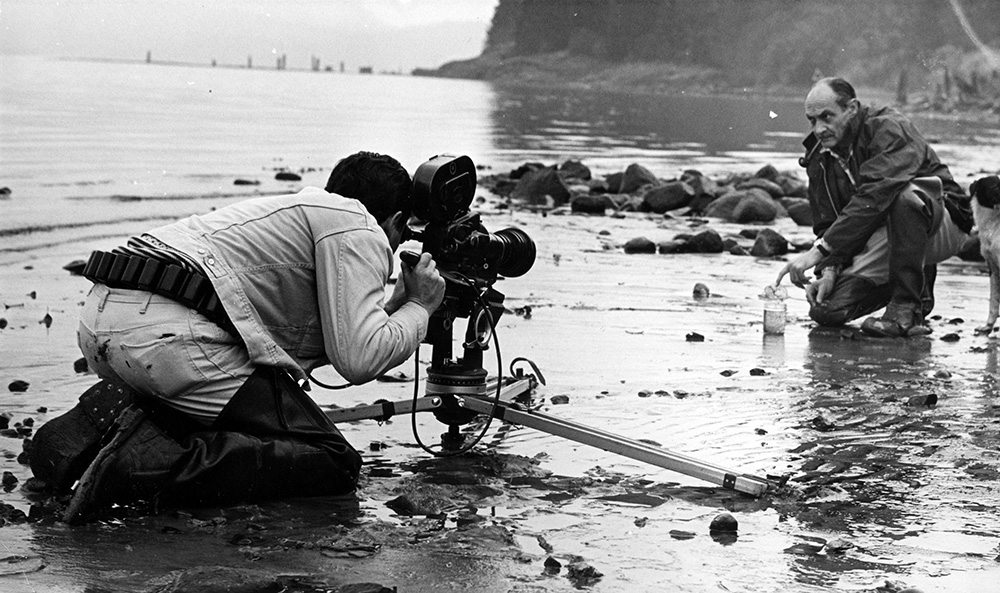[Editor’s note: This series is drawn from Andrew Nikiforuk’s talk “Why Haig-Brown Matters More than Ever,” given last month in Campbell River at the Seventh Annual Haig Brown Memorial Lecture. A PDF is available here.]
Nearly a half-century ago, B.C.’s greatest voice for conservation, Roderick Haig-Brown, wrote prophetically about fish hatcheries. Every year the province releases nearly 300 million hatched fish into the ocean while other Pacific nations such as Japan, Korea and the United States pour about 5.2 billion fish into the ocean.
Politicians have always liked technology because it allowed them to avoid the real problem: the destruction of streams and spawning grounds by machines, logging and dams.
Moreover hatcheries promised to boost lost salmon production with little effort and therefore became a wildlife recovery fashion in the 1970s. But hatcheries, of course, are artificial environments. By crowding 50,000 fish in a concrete pool and feeding them pellets, humans inadvertently waded into the subtleties of fish evolution and changed the fish altogether.
Not surprisingly Haig-Brown was one of the first to express limitations about this miraculous technological fix. He feared that hatcheries would produce, over time, highly specialized breeds and would deplete the natural versatility of the stock.
As an angler he could see the results in rivers he frequented. Well-grown hatchery smolts often outcompeted smaller wild stock in the streams for food. Once hooked on a fishing line, some hatchery fish fought as well as stock fish, but others behaved as limply as Dolly Vardens, wrote Haig-Brown. They just didn’t have any fight in them.
Moreover he suspected that hatchery stocks would degrade wild stocks with inter-breeding and thereby reduce the range and variability of wild fish.
The angler conceded that there might be a role for some hatcheries, especially in grossly damaged watersheds, and that provincial trout hatcheries served a useful purpose. But he ultimately feared that governments growing dependence on salmon hatcheries — a $15-billion habit in the United States since 1978 — reduced the will to attack the real problems.
“The best way of restoring salmon and steelhead runs to their full glory is the hard way,” argued Haig-Brown. It was the “close protection and management of existing stocks, stream rehabilitation and improvement and greatly improved land management.”
In 1969 he confessed to one correspondent, “I am almost tempted to say: Take care of the rivers and streams and the rest will take care of itself.”
Studies confirm Haig-Brown’s alarms
The science, of course, has confirmed Haig-Brown’s worst suspicions. Hatchery fish are not only much genetically different than wild fish but a lot less hardy. Studies at Oregon State University show that genetic differences between hatchery and wild fish are large in scale and fully heritable.
After years of genetic studies on thousands of steelhead trout, researchers concluded “that fish born in the wild to two hatchery-raised steelhead have only 37 per cent the reproductive fitness of a fish born to two wild steelhead.” They found that “a fish born to one wild and one hatchery-raised fish has only 87 per cent the reproductive fitness.”
Scientists could measure the differences for a full generation in the wild. The evidence now suggests that the technology has overpopulated the North Pacific Ocean with hatchery fish and these inferior fish are having real impacts on the abundance of wild salmon.
Haig-Brown was right: hatcheries have never been and can never be a substitute for stream protection.
BC’s own Silent Spring
In many ways Haig-Brown was always cutting trail. In 1959, three years before Rachel Carson published Silent Spring, he wrote about the disastrous effects of DDT on fish-bearing streams in Fisherman’s Summer. In a chapter called “The Great Destroyers,” he even detailed how DDT spraying for budworm near the Miramichi River had wiped out fingerling salmon. He called it “an outrageously evil practice” and castigated the professionals who carelessly employed the technology:
“I have never yet met a forester who professed to know precisely what he was doing when broadcasting his pet poison over a great area of forest. Generally he expected to ‘control’ the specific pest that was bothering him; how thoroughly or for how long, he did not know; what else might be killed, he did not know; what would be the effect of wiping out natural controls, such as birds and bees, he did not know; how often the treatment would have to be repeated to compensate for such destruction; he did not know; how long its evil effects might persist, he did not know. Yet someone had given permission to go ahead and do the damage.”
You could take that passage, replace forester with shale gas driller and DDT with the hydraulic fracking and not miss a beat.
Tomorrow, the series continues: How Roderick Haig-Brown fought his era’s version of the Site C dam project. ![]()
Read more: BC Politics, Science + Tech, Environment


















Tyee Commenting Guidelines
Comments that violate guidelines risk being deleted, and violations may result in a temporary or permanent user ban. Maintain the spirit of good conversation to stay in the discussion.
*Please note The Tyee is not a forum for spreading misinformation about COVID-19, denying its existence or minimizing its risk to public health.
Do:
Do not: